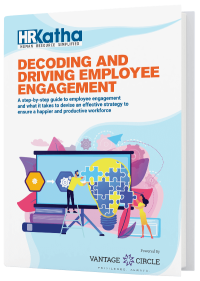2021 Employee Engagement Statistics For Those In A Manager’s Role

For people in a manager’s role, 2021 brought countless new ideas and obstacles to the table.
Expectations are at an all-time high for the managers who have to be at the top of their game. People in the manager’s role know how overwhelming it all can be.
Effective managers have to be good at human skills, conceptual skills. Also, they are good at getting the hang of the new technologies available.
On top of that, they have to keep up-to-date on the latest employee engagement trends!
Manager’s Role in Employee Engagement
It may all seem daunting, isn’t it?
All these piled up expectations have resulted in stress among the managers. Eventually, it will result in extreme burnout and dwindling productivity.
The manager’s role in keeping the team happy, motivated, and engaged is immense.
When a manager can’t function properly, the team grinds to a halt. In many ways, a manager is a link between employee engagement and senior management.
A managerial role demands a lot from its occupants. Every manager represents:
- An efficient resource allocator.
- Have good human resources skills.
- Fulfill the informational role. It means being an effective spokesperson.
- Also, should be able to handle interpersonal roles. It means being someone who can be trusted to lead.
- A functional manager should have sufficient technical skills.
- Conveys information clearly and concisely.
This article is for those in the manager’s role to make things easier on the employee engagement front.
Thus, a manager’s role is hard, as established. Having a list of the most crucial employee engagement statistics will definitely help.
Here are the top employee engagement statistics so that managing 2021 becomes a little easier.
Top 5 Statistics Of 2021 To Redefine The Manager’s Role
Here are the top 5 employee engagement statistics of 2021 that changed our expectations from a manager’s role.

(Source: Unsplash)
1. 29% of employees cited their benefits package as a top reason to look for a new job.
A survey conducted by SHRM revealed something interesting. About 29% of employees are more likely to look for a new job if the benefits package is not up to their satisfaction.
Companies that used employee benefits as a strategic tool for retention were twice as likely to have an engaged workforce. It also brings about better company performance as compared to companies without any employee benefits.
This illustrates how powerful benefits are. Benefits can save a company a substantial amount of cost in the long haul and also engage employees.
How To Fix This As Someone In The Manager’s Role:
- Devise a strategic and attractive employee benefits program.
- Provide a benefits statement that highlights the monetary value of each benefit.
- Show employees how their benefits compare with competitors in the same region.
- Flexible employee benefits choices. Offer a point-based rewarding system.
- Share the progress of expanding employee benefits over time with employees.
2. Only 14% of employees strongly agree that the performance reviews they receive inspire them to improve.
Fewer than three in 10 employees believe their performance reviews are accurate.
For the ones in the manager’s role, it might seem to be a mighty task. However, the best managers recognize an employee’s potential. They also show how an employee can improve their future work performance.
A performance review should be elemental in discussing the employee’s strengths as well as weaknesses.
Focusing on the employee’s strengths helps the employee to stay motivated. Whereas the negative feedback gives a basis on where to improve and push their best performance forward.
How To Fix This As Someone In The Manager’s Role:
- To begin with, review an employee’s performance at least once every six months. Reassess an employee’s performance, goals, and priorities.
- Again, ensure that the expectations from the employee are fair. Consider the time and resources made available to the employee.
- Meanwhile, focus on the three most important aspects of a performance review. They are individual achievement, team collaboration, and customer value.
- Also, prioritize developmental needs just as much as immediate performance metrics and goals. It might be special projects, skills training, or mentoring experiences.
3. 69% of millennials show loyalty to diverse and flexible work cultures.
According to a study by Deloitte, millennials place diversity as a basis for loyalty.
Attracting and retaining millennials begins with financial rewards and workplace culture. It is further enhanced when businesses and their senior management teams are diverse.
Also, millennials are more attracted to workplaces that offer higher degrees of flexibility.
Those who are less than satisfied with their pay and work flexibility are increasingly attracted to the gig economy.
How To Fix This As Someone In The Manager’s Role:
- Given more millennials taking the helm of leadership positions, things are changing. We’re bound to see a bigger push for diversity and inclusion programs and incentives.
- Particularly building a more flexible work culture. Some options are offering work from home options or flexible work timings.
4. 79% of employees who quit their jobs cite a lack of appreciation as a key reason for leaving.
A global study revealed that “lack of appreciation” is the main reason employees quit.
The element that shows up repeatedly in every great workplace is a manager’s ability to recognize employees’ talents and contributions in a meaningful manner.
So it must be value-based recognition. Recognition done wrong will NOT offer the same immediate returns as value-based recognition.
Recognition must be timely. It must be specific. And it must be frequent.
Study results show that when recognition is considered an integral part of the culture, companies:
- Have lower turnover rates.
- Also, achieved enhanced business results.
- And are seen as much more robust in what we call the Basic Four areas of leadership. They are Goal-setting, Communication, Trust, and Accountability.
How To Fix This As Someone In The Manager’s Role:
- One factor when it comes to initiating a recognition program in a company is consistency. A keynote speaker can introduce the concept, use precise terminology, and explain the dos and don’ts.
- Lest, it sounds easy to start recognizing employees. But it isn’t so. The companies that are reaping the greatest results are those who train their managers.
- Also, create monthly meetings where managers from different departments can share stories about recognition. Mainly about what worked with their teams and what might not work.
- Frequently ask others in your profession what they do to recognize their employees. One piece of advice may not work inside every team or company, but it may inspire ideas.
5. 89% of employers think employees leave for money. Meanwhile, only 12% actually do leave for money.
Leigh Branham, the author of The 7 Hidden Reasons Employees Leave, revealed that 89% of bosses believe employees quit because they want more money.
That’s what anyone in the manager’s role would like to believe, isn’t it? Thinking that money makes the world go round actually stops us from taking responsibility.
The reason why the best people are leaving your workplace is not what you think. Only about 12% of employees actually leave an organization for more money.
Employees don’t just come to work for a paycheck. We spend so much time in the office that it’s important to feel excited about coming to work. Dreading your workday isn’t worth the money.
How To Fix This As Someone In The Manager’s Role:
- To begin with, focus on building a work culture that values equality and strong teamwork. An employee spends most of his/her time with their teams.
- Recognition-based programs. It will take a little of your effort but build a strong appreciation culture.
- Next, encourage a communication-based culture. Be the manager they respect, not fear. Encourage peer-to-peer reviews as well as frequent feedback.
- Also, encourage work-life balance. Too much work will build resentment and stress among your employees.
- Meanwhile, don’t forget to bring some fun to the team.
In Conclusion
Finally, remember that keeping your employees engaged should be your prime agenda.
Stay up-to-date on various employee engagement trends and statistics. It will make everyone in the manager’s role effectively fulfill their job and get ready for 2021.

Vantage Circle is a simple AI-powered Rewards & Recognition Platform for upgrading your employee experience and engagement for better productivity.






